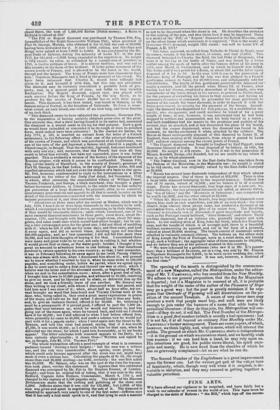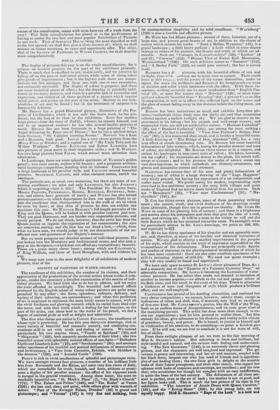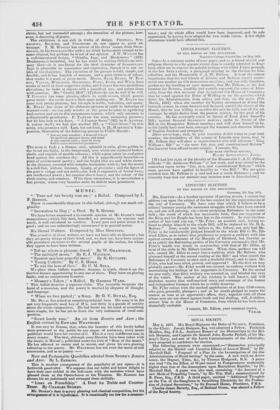FI-NE ARTS.
WE have allowed our vigilance to be surprised, and have fairly lost a week in our calendar of events in the world of art. This lapse must be charged to the debit of Reform : " the Bills" which lops off the excres. cences of the constitution, seems with us to have cut off a week from the year! This little miscalculation has placed us in the predicament of having to notice the two best and most popular Exhibitions of Pictures in one week. That of SOMERSET House, being the most dignified as well as the last opened, we shall first give a short account of ; which we shall resume on future occasions, as space and opportunity offer. The other, that of the SOCIETY of PAINTERS in WATER COLOURS, we shall describe more comprehensively.
ROYAL ACADEMY.
The display of pictures this year is on the whole unsatisfactory, for it evinces no marked progress on the part of the exhibitors generally. There is much that is excellent in art, undoulnedly, and we perceive no falling off 011 the part of individual artists, while some of rising talent give proofs of improvement ; but in the highest walk there are compa- ratively but few attempts, and those are, with one or two exceptions, not eminently successful. The display of colour is gorgeous, and there are some beautiful pieces of effect ; . but the drawing is painfully indif- ferent in too many pictures, and there is a pitiable lack of invention and expression, and indeed of all those qualities of a picture which require
power, and genius on the part of the artist. Mastery in the tech- nicalities of art may be found ; but in the treatment of subjects it is lamentably deficient.
Mr. BRIGGS has a grand Historical picture, illustrative of the Pro- gress of Civilization ; which is not only the finest work be has ko. duced, but the best of its class in the exhibition. ETTY has another large picture from the story of Judith, wherein he repeats himself, and not in all improved manner: he has also several smaller pictures of merit. has not been fortunate in a large painting of " The Angel delivering St. Peter out of Prison ;" but he has a spirited design from SPENSER, " Sir Calepine rescuing Serena." Newros:. has a Lear and a Bassanio, both good. LEST.1E has a very clever picture from the Merry Mors of Windsor. and a capital one of " My Uncle Toby and the Widow Wadman." Messrs. EASTLAKE and Einvirs LANDSEER have also pictures of great merit in their respective styles ; aid R.-Wesism, has two large pictures from FAUST, which attract more attention than admiration.
In Landscape, there are some splendid specimens of TURNER'S golden pencil ; two coast scenes, replete with beauty ; and a gorgeous architec- tural landscape composition, dazzling with its 'richness. CONSTABLE has a large landscape in his peculiar style, and CAT.LCOTT several beautiful pictures. STANFIELD, COLLINS, and other eminent names, enrich the catalogue. The portraits are, as usual, very numerous, but there are none of sur- passing excellence ; we miss not only LAWRENCE, but also JACKSON ; which is surprising—how is this ? Tile President Sir MARTIN SHEE, Messrs. PHILLIPS, PICKERSGIII., BRIGGS, RE1NAGI.E, ROTIIWELL, Si:m.-
50N, and others, have portraits of merit ; and Wiratis: has also turned
portrait-painter,—in which department he does not appear likely to at- tain the excellence that distinguished him in the walk of art to which
he owes his fame ; of that class of pictures he does not exhibit one
specimen this year. Sir WILLIAM BEECHEY'S full-length portraits of the King and the Queen, will be looked at with peculiar interest just now.
They are good likenesses, and are besides very respectable pictures, and neatly painted. We do not think, however, that the artist has done the Queen justice as regards the expression of her countenance ; the eyes arc somewhat staring, and the face has too fixed a look,—which, from what we have seen, we should judge to be not characteristic of the un- affected ease and quietness of her Majesty's manner.
But we must postpone our detailed account of individual pictures. We just looked into the Miniature and Architectural rooms, and also took a
peep at the Sculpture,—which does not afford any extraordinary beauties. There are a great many clever busts ; among which are ClIANTREY'S, of King William, and three of Lord Brougham, with and without his wig.
We must now turn to the most delightful of all exhibitions of modern pictures, that of the
SOCIETY OF PAINTERS IN WATER COLOURS.
The excellence of this exhibition, the number of its visitdrs, and their appreciation of the productions of the several artists whose worksit com- prises, render less necessary a detailed examination of the merits of indi- vidual pictures. We have little else to do but to admire, and we enjoy the treat afforded us accordingly. The beautiful and natural effects produced by the English school of water-colour painters are quite unap- proached by any other : the force, splendour, richness, delicacy, and variety of their colouring, are extraordinary; and when this perfection of art is employed to represent the most lovely scenes in nature, with all the vivid freshness and glowing warmth which its varied hues shed over the scene, and with that truth which a feeling for her beauties, on the part of the artist, can alone lend to the works of his pencil, we feel a degree of national pride as well as delight and admiration.
The first who claims our notice is COPLEY FIELDING, the excellence of whose style is proverbial. He has this year thirty-six drawings, rich in every variety of beautiful and romantic scenery, and combining con- summate skill in art with truth and feeling of nature. We noticed particularly his two marine views, "Vessels at Spithead" (35), and " Shipwreck" (158), both masterly productions of their kind ; also two beautiful scenes with splendidly natural effects of sun-light—"Dolbadern Castle and Llanberis Lake " (79), and "Southampton " (95); and amongst other specimens of his truthful and poetical delineations of mountainous and level scenery, a "View from Cannobie, Eskdale, with Skiddaw in the distance" (138), and " Arundel Castle" (180).
PROUT is rich in vivid recollections of splendid and picturesque ruins. We have amongst twenty-four pictures, a number of his brilliant little bits from Normandy and the Rhine, and some very fine views of Italy, -which are remarkable for truth, breadth, and force, without so promi- nent a display of his peculiar manner : the effect of his vigorous touch is merged in the general treatment. Among these latter, the most re- markably beautiful are, "St. Mark's Place" (2), "St. Mark's Church" (174), " The. Palace and Prison" (249), and "The Rialto" at Venice. (328); the last cool, clear, and quiet, while others glow with warmth of colour. "Part of the Zwinger Palace, Dresden" (28) is grand and picturesque; and Verona" (107) is very fine and striking, from its unostentatious simplicity and its solidkexcellence. " Wurtzburg" (139) is also a forcible and effective picture.
DE Wiser has but fifteen pictures ; several of them, however, are of a large size, and possess great beauty of art, in addition to the charm of nature which invests his works. ""Nant y Bellan, Wynnstay" (41), is a grand landscape ; a little heavy perhaps ; a fault which in some degree belongs to others of his pictures, the beauty and truth of which are ad- mirable. Such are " Cottages in Carnarvonshire" (50), " Ludlow" (8 and 21), "Conway" (212). " Distant View of Forest Hall Mountains, Westmoreland " (256). On such delicious scenes as "Summer" (152), and "A Barley Field" (222), we could gaze unfired ; the last is nature itself.
BARRETT has a dr pictures, with his beautiful effects of sun and
twilight, than nothing can be more true to nature. Their excel-
lence in this resinaL, and the poetry of the scenes themselves, make us regret the more the feebleness and flatness of his foregrounds—a want of decision and relief which interferes with the effect. With these ex- ceptions, nothing certainly can be more resplendent than " English Pas- toral" (9), or more like nature than " Morning" (126), or more tran- quil and solemnly beautiful than " Evening" (64), a picture CLAtain-like in composition as well as in effect—the reflected light on the water, and the glow of sunset fading away in the distance before the rising moon, are p RousoN has been industrious as usual, and exhibits forty-four pic- tures,—cathedrals rising dimly into the dusky air, and blue mountains relieved against a mellow twilight sky. We are glad to observe an im- provement in his foliage ; but his smooth and well-swept scenery, and empurpled tints, are still too artificial for nature. " Durham Cathedral" (70), and " Dunkeld Cathedral" (104), are among the most striking ; the efliet of the last is beautiful. " View from Prebend's Bridge, Dur- ham" (92), is less mannered than usual, and is besides a beautiful scene. A little drawing of " The Bridge of Don, Aberdeen" (98), has a very true effect of clouds threatening rain. Mr. Bousosr has some beautiful delineations of lake scenery, which, bating his peculiar manner and tone of colour, are delightful. Mr. Ronsoie views nature as in a camera, and attires his landscapes in neat court suits of velvet : his lakes, however, are not ruffled; his mountains are downy as the plum, his meads well- swept as a carpet ; and in his pictures the realm of nature seems one vast drawing-room, in which cathedrals are chimney-ornaments, and groves and mountains screens and ottomans.
GASTINEAU has twenty-four of his neat and pretty delineations of scenery ; one of which is a large drawing of the " Lago Maggiore" very nicely painted, but haring the appearance of a set composition, and rather tame withal. We prefer seeing his modest, unpretending style exercised in less ambitious scenery ; the snug little villages and quiet nooks of England find no mirror more faithful than his pictures. Such are " Beaumaris" (23), " View near Clackmannan" (31), " Ma- chynlleth" (101), &c.
D. Cox has thirty-seven pictures, many of them possessing striking merit ; the nature, truth, and vivid freshness of his drawings render them admirable, though they are in general too sketchy. He rivals DE WINT in some of his pleasing bits of scenery ; and there is a brightness and motion about his atmosphere and skies that give the idea of a cool, moist, and stirring air. It will be a treat to the visitor to cull out the little flowers which he has scattered round the room. To exemplify what we particularly admire in Mr. Cox's drawings, we point to 298, 325, and especially to 377.
W. HUNT has thirty specimens of his singular and not agreeable man- ner, and, therefore, as many of his forcible and identical imitations of nature. We are glad to observe a marked improvement in the put vise of his style, which consists in. the truth of expression superadded to the vraisemblance of his delineations. They are principally-rustic figures and studies of character, in the physiegnomical developinent of which he has been most successful : there are also while excellent specimens of his skill in imitating objects of Still-life. We need not quote examples ;
they will very readily belound and appreciated. -
We have only space ton:nice D. LEWIS'S clever pictures of Dogs, &c.; and a masterly one of the "Exterior of a Venetian Curiosity Shop," an admirable composition. Mr. LEWIS is becoming the LANDSEER of water- colour painters. He has talent that needs not descend to imitationef another to become popular,—we allude to the red and opaque colour of his flesh tints, and the touch in the coats of hiS dogs. There is otherwise a freshness of tone and sharpness of style which produce a brilliant effect, and are well employed. CATTERMOLE has several of his dazzling obscurities, and confused but very clever compositions ; we cannot, however, admire them, except as indications of talent and skill, that, if matured, may lead to excellence of first-rate kind. Mr. CATTERMOLE'S genius, like the Will o' the Wisp, leads us an endless dance of disappointment, and we soon grow tired of the tantalizing pursuit. This artist has done more than enough to ex- cite our expectations ; now let him proceed to realize them: Let him embody his ideas, give substance to his shadoWs, and reality to his visions of grandeur, beauty, and power.. He is bound, in justice to himself and in vindication of his admirers, to do something—to paint a finished pic- ture. If he will not, we are free to conclude it is not for want of will, but of ability. From these twilight glimpses of art we turn to the fair morning of Miss L. SHARPE'S talents. Her colouring is fresh and brilliant, her style tasteful and natural, and she evinces both feeling and understand- ing. " The New Governess " (149), is an extremely clever and pleasing picture, and the characters are well imagined and expressed. The go- verness is pretty and interesting, and her air and manner, coupled with her black dress, bespeak one who has need of friends and is apprehen- sive of not finding them; the two little girls in delight at the amiable looks of their future preceptresS, and their elder sisters, whO regard her askance with looks of suspicion and contempt, are excellent ; and the bro- ther, who scrutinizes her though his eye-glass with an easy indifference, is quite the beau of the last century. The delineation of all these per- sons is perfect, even to the air of each ; the mother is ;not so.good, and her figure. looks stiff. • This is much the best picture of its class in the exhibition. " The interview of Jeanie Deans with Queen Caroline," (181), and the "Erring Sister" (320), by this young lady, are not equally happy. Mid R. Samtra's " Rape of the Lock " is a bold and
clever, but not successful attempt ; the execution of the picture, how- ever, is deserving of praise.
The exhibition is not rich in works of design. CRISTALL, STE.. rHANOFF, RICHTER, and CHISROLME do not appear to great ad- vantage. T. M. WRIGHT has several of his clever scenes from SHAK- MIRE, in his STornsun-like style ; we think he has merit enough to be- come original, but perhaps he is not of our opinion. J. W. 'WRIGHT has a well-intentioned design, "Othello, Iago, and Desdemona " (318). Desdemona is beautiful, but he has erred in making Othello an ordi- nary Moor—it is too literal for the ideal character of SHAKSPEARE. lago is admirable in conception and expression, though it is not our idea of the character. The execution of the picture is bold, simple, and forcible, and it has breadth of manner, and a quiet richness of colour, that render it a work of great merit. Messrs. NASA, BYRNE, W. Tee- nen, VARLET, WHICH ELO, MACKENZIE, PUOIN, Essex, and Wuss, have works of merit in their respective styles, and COT:SIAN has two atrabilious elevations; he looks at objects with a jaundiced eve, and paints them with gamboge. His " Crosby Hall" (47) shows he can do well if he will. T. FIELDINC: has some pleasing effects in cattle scenes, which possess great merit the cattle want a little more making out. W. EVANS has some very pretty pictures, but his style is feeble, indecisive, and spotty. R. HILLS has some of his elaborate pictures of cattle in imitation of worsted work : we can only wonder at the pains he takes in sacrificing both nature and art to this monotonous texture, which only amounts to a disagreeable peculiarity. P. TAYLOR has some promising pictures ; but let him look to his faces. " A Cottage Scene" (97), by S. AUSTIN, is nature itself; we had also marked 215, a " Coast Scene," by this artist, who promises well. Last, but not least, is 71, HARDING'S Com- position, illustrative of the following passage in Childe Harold :
" But my soul wanders ; I demand it back To meditate amongst decay, and stand A ruin amidst ruins ; there to track FalPu states and buried greatness."
The scene is Italy ; a Roman arch, splendid in ruin, glows golden in the broad sun-light, in the foreground, over which are scattered broken shafts and capitals of marble columns ; while a pine raises its cool green Lead against the cerulean sky. All this is magnificently beautiful—a piece of architectural poetry ; and the bright blue sea and white shores in the distance, crowned with temples, harmonize with it ; but the centre is a dull blot, without interest, beauty, or grandeur ; and the figure of the poet is vulgpr and not noble—his look is expressive of brutal force, not intellectual power; his costume also is heavy, and the colour of the cloak staring and common. With these exceptions, it is nevertheless a fine picture, whose very beauties make its defects more prominent.




























 Previous page
Previous page